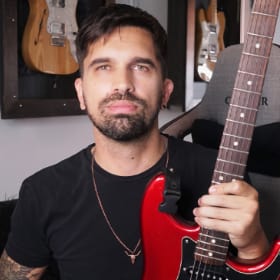now playing:
More
- 16th Notes PhrasingLEVEL 4In this study, we'll learn how to develop improvisation ideas over 16th note patterns.
- 16th Notes ExerciseLEVEL 1Practice timing and playing 16th notes using interactive exercises.
- Palm Muting 16th NotesLEVEL 4In this lesson we will discuss palm muting of 16th notes.
- 16th Shuffle SoloLEVEL 5Get comfortable with the 16th Shuffle rhythm to spice up your vocabulary!
- Tapping in 16th TripletsLEVEL 6This lesson shows what can be done with only one simple tapping pattern. Moving through the scale while tapping and producing the whole solo with just one simple pattern.
- Speed BuildingLEVEL 4Exercises & tips to play faster, based on this simple principle: Speed is a by-product of accuracy.
- Modern Rock SoloLEVEL 8This solo illustrates how to put your licks together and produce a modern solo which has a melody rather than just random thrown licks.
- Shuffle Fusion BluesLEVEL 8Fusion tune with advanced Blues licks. Techniques used in this lesson: Alternate Picking, Vibrato, Bending, Classical Rock Licks, Legato. Whammy bar.
- Building Chord ProgressionsLEVEL 1Learn how to build chord progressions in Major Keys.
Feedback
 thefireball27th October 2010
thefireball27th October 2010Amazing!!!
 Muris Varajic7th December 2009
Muris Varajic7th December 2009This was great!!

 Krisztian Lovrek1st December 2009awesome lesson with an awesome solo
Krisztian Lovrek1st December 2009awesome lesson with an awesome solo
Thanks Marcus
 Marcus Siepen30th November 2009
Marcus Siepen30th November 2009awesome lesson with an awesome solo

 Krisztian Lovrek29th November 2009Great lesson,well done man !!
Krisztian Lovrek29th November 2009Great lesson,well done man !!
Thx!Hey man! This is really powerful! Thanks for producing it!
I'm glad you like it. NoSkill28th November 2009
NoSkill28th November 2009Hey man! This is really powerful! Thanks for producing it!
 Sinisa Cekic28th November 2009
Sinisa Cekic28th November 2009Great lesson,well done man !!

 Krisztian Lovrek27th November 2009I love abnormal solos!
Krisztian Lovrek27th November 2009I love abnormal solos!
good lesson!
Abnormal? :-)Killer sounding with a great solo! Nice job Krisztian!
This is a Roland Micro Cube very well done man, there´re some awesome licks I wanna put an eye on
very well done man, there´re some awesome licks I wanna put an eye on thanks!
thanks!
Thanks! Daniel Realpe24th November 2009
Daniel Realpe24th November 2009I love abnormal solos!

good lesson! Vasilije Vukmirovic24th November 2009
Vasilije Vukmirovic24th November 2009Great licks!

 Lian Gerbino23rd November 2009
Lian Gerbino23rd November 2009very well done man, there´re some awesome licks I wanna put an eye on
 thanks!
thanks! Laszlo Boross23rd November 2009
Laszlo Boross23rd November 2009Killer sounding with a great solo! Nice job Krisztian!

 Krisztian Lovrek23rd November 2009
Krisztian Lovrek23rd November 2009Thanks all of you!
 Sergio Dorado23rd November 2009
Sergio Dorado23rd November 2009Very inspired solo, Krisztian! Sounds awesome
 Jerry Arcidiacono23rd November 2009
Jerry Arcidiacono23rd November 2009Cool solo, I like the licks at the end

 Stephane Lucarelli23rd November 2009
Stephane Lucarelli23rd November 2009Great licks here Kristian, well done!
 Gabriel Leopardi23rd November 2009
Gabriel Leopardi23rd November 2009Killer stuff man! Well done!
 playaxeman22nd November 2009
playaxeman22nd November 2009Heavy metal heaven!!
wow what a greaaaaaaat lesson this is Alexiaden9322nd November 2009
Alexiaden9322nd November 2009Wow ! You have an amazingly clean sound, and the solo was very melodic. You kick bum ! xD
 Krisztian Lovrek22nd November 2009The petrucci guitar gives immediate petrucci sounds
Krisztian Lovrek22nd November 2009The petrucci guitar gives immediate petrucci sounds cool man!!
cool man!!
:-) Petrucci has the best guitar sound (for me ). After him comes Marco Sfogli and Kee Marcello. Clare22nd November 2009
Clare22nd November 2009KILLER Solo krisz!! Excellent work as always, i,m really liking your style Bro!
 Bogdan Radovic22nd November 2009
Bogdan Radovic22nd November 2009Very good solo lesson!

 Gerardo Siere22nd November 2009
Gerardo Siere22nd November 2009Great Job!
 kaznie_NL22nd November 2009
kaznie_NL22nd November 2009The petrucci guitar gives immediate petrucci sounds
 cool man!!
cool man!! Wilska22nd November 2009
Wilska22nd November 2009Amazing Krisztian! Wonderful lesson and interesting solo
 Krisztian Lovrek22nd November 2009Love your vibrato! It's very sophisticated! Also the whole lead is greatly executed, well done, bro!
Krisztian Lovrek22nd November 2009Love your vibrato! It's very sophisticated! Also the whole lead is greatly executed, well done, bro!
Thx bro, my next lesson will be about the importance of vibratos :-PGreat control man, well done with this solo!
Thanks! Ivan Milenkovic22nd November 2009
Ivan Milenkovic22nd November 2009Great control man, well done with this solo!

 Zsolt Galambos22nd November 2009
Zsolt Galambos22nd November 2009Love your vibrato! It's very sophisticated! Also the whole lead is greatly executed, well done, bro!

 Krisztian Lovrek22nd November 2009
Krisztian Lovrek22nd November 2009Thanks guys!
 Emir Hot22nd November 2009
Emir Hot22nd November 2009Great stuff. Very powerful solo.
Braer22nd November 2009
awsome solo

 Kristofer Dahl22nd November 2009
Kristofer Dahl22nd November 2009Very cool solo with unexpected twists!

Practicing Peers
- Total views: 0
- Member views: 0
- Guest views: 0
- Lesson
- My notes
Hi Everyone and welcome to my second lesson!
I wrote this piece especially for you! It can help you practice the 16th note picking, which is harder than it seems at first glance. Guitar playing technically is all about creating a harmony between your hands (to pick the string(s) that your are holding down with your other hand on the fretboard at same time). If you can achieve it, you have to maintain it, that's why continuous practice is very important. I think a good guitar player is like a sports man, always taking care of his (technical) condition.
On the other hand, the soul of guitar playing is the vibratos and bendings. I am pretty sure that I will repeat this a lot of times, because I can never emphasize on it enough. I put slow and long bendings into this lesson, and I also put a lot of slides, and a short legato with tapping. I like to combine different techniques in a solo. Keeping people's attention is not easy, and if you keep doing the same thing, you can easily become boring.
By the way, I like to use the whole neck to play the notes, not only 1 or 2 directions as a lot of people do. If you know the scales and possibilities on the whole fretboard, your playing could be exciting for you and for your audience, as well. In the future I will teach you the modes and some other scales on the whole neck, but for now let’s get back to the lesson.
The lesson's key is F# minor. The first part of this one will show you how to build up your solo the right way if you want to use the classic method to repeat a part. It starts with a melody with bendings, followed by a part which serves as a bridge to the same melody one octave higher (mind your vibratos! Do not be nervous!). If you check the lesson's structure you can see that it contains a main riff which is a "verse", after that it is a modulation to C# phyrigian dominant/ harmonic minor, this is the "bridge" to the "chorus" part which steps back to F# minor.
Because of the whole lesson's structure we need to plan how to build up the whole solo to keep the music's structure.
That's why after I play the melody part an octave higher I use a descending run with slides and legato with tapping, and a bending with tapping (pay attention to your vibrato on the tapped note).
You should do it with your fretting finger but you have to help it with your tapping finger! Right after that comes the modulation; here I used a bit of palm muting to make a staccato sound. The next run is a classical one (with a bit palm muting again), Yngwie Malmsteen used this a lot (usually faster). This is to help catch the F# note on B string (with bending) which is the first note of the "chorus" section (mind your vibratos! Switch to the neck pickup).
30-31 bars contains a F# minor arpeggio which I used with alternative picking 36th bars has another arpeggio part and then comes a slide run to get the final note which is an F#.
I hope you enjoy this one, good practicing everybody!
-KrisztianFrom this course:
Jump to start: Home or `s` , you can also click/tap the lesson part again (the numbers above player)
Go to next part: PageUP or End.
Volume: ArrowUp / ArrowDown keys
Go to any part: Number keys (combinations also possible)
Pause or play: `k` or space key
Fullscreen: `f`, esc to close
Increase / decrease speed : `+` or `-`







